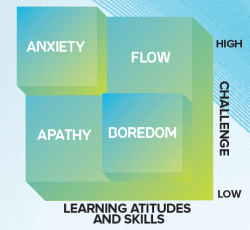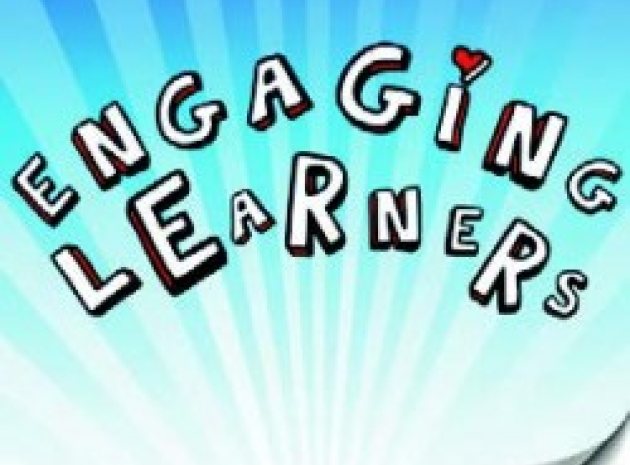
For over 30 years, Professor Mihaly Csikszentmihalyi has been the world’s leading expert in the field of optimal performance. He first set out studying famous writers, musicians, artists, academics, engineers and Nobel Prize winners trying to discover why and how they attained their high levels of performance.
They described back to him the characteristics of flow – moments when time disappears as you completely lose yourself in the activity you’re engaged in. Minutes become hours, hours become days. You become so focused and engaged that distractions cannot enter your thoughts. Such activity is highly pleasurable. He refers to these experiences as autotelic.
Csikszentmihalyi widened his search to ordinary people like you and me and has since studied more than 100,000 individuals of all ages, genders, races, backgrounds and occupations. It seems that all his subjects are capable of this state of flow across a vast arena of experiences. For some, it comes through their relationships, for others it’s in their work, their hobbies or in sporting activity.
Flow occurs when high skill levels meet high challenge as shown in the diagram below. The pressure of cooking a meal, for example, can easily create flow as you blend the ingredients and coordinate all the different elements of the dish so they are ready simultaneously. However, if the challenge level is lowered to beans on toast, the result may well be boredom as your cooking skills are hardly being extended. At the other end of the scale, if ordinary people were parachuted into top London restaurants and given the responsibility of cooking Michelin-starred cuisine, the likely reaction would be high levels of stress and anxiety.
Even the most challenging of teenagers get into flow. Don’t believe us? Just listen to them discuss the hours they’ve spent trying to get to the next level on Call of Duty on their PlayStation console or time spent on Facebook. However, Csikszentmihalyi’s studies of school-age children indicated that there was far too little flow during their school day, when such things as automated bells, set times for work, externally imposed syllabi and disturbance from peers constantly interrupt the opportunity for autotelic experiences to develop.
The 6 foundations of flow
Based upon lesson observations we’ve found that flow rarely occurs without all of the following six foundations below being in place. Each element is important:
1. Tasks are appropriately challenging
What we mean by this is that each of the ability groups within the class is equally stretched.
We don’t mean that every student is working on the same challenging activity. Indeed, there won’t be flow where students are totally confused because they are out of their depth or waiting for others to catch up.
A particularly useful tool for guaranteeing deeper learning and flow in the classroom is Bloom’s Taxonomy. This provides a hierarchy of progressively more challenging thinking, from remembering up to creating. Flow occurs when learners get the chance to move beyond simple remembering and understanding activities. Where lesson objectives are very knowledge or content based there is unlikely to be much flow.
Bloom’s revised taxonomy
Creating – Putting elements together to form a coherent or functional whole; reorganising elements into a new pattern or structure through generating, planning or producing. This can involve designing, constructing, planning, inventing, devising, programming, filming, animating, blogging, mixing, video-casting and podcasting.
Evaluating – Making judgements based on criteria and standards through checking and critiquing. This can involve hypothesising, critiquing, experimenting, judging, testing, detecting, monitoring and reviewing.
Analysing – Breaking material into constituent parts, determining how the parts relate to one another and to an overall structure or purpose through differentiating, organising and attributing. This can involve comparing, contrasting, organising, deconstructing and attributing.
Applying – Carrying out or using a procedure through executing or implementing. This can involve implementing, carrying out and using.
Understanding – Constructing meaning from oral, written and graphic messages through interpreting, exemplifying, classifying, summarising, inferring, comparing and explaining.
Remembering – Retrieving, recognising and recalling relevant knowledge from long-term memory. Source: Anderson and Krathwohl (2001), as cited in Forehand (2008)
2. Teacher input is minimal
What we mean by this is that the teacher has structured the lesson so that there are many opportunities for the students to work either individually or collectively.
We don’t mean that the teacher is sitting at their desk marking or reading a newspaper! They will be circulating the room and gaining feedback on progress.
One of the most common reactions we get when teachers watch themselves on DVD for the first time is: ‘I was shouting at the screen – “Shut up!” ’ Often they had been aware that they talked a bit too much; but not to the extent that their talking actually hindered learning. The DVD playback is often a powerful wake-up call to plan much more and talk far less.
3. Classes have the necessary learning skills
What we mean by this is that students have the attitudes, skills and habits to work independently for long periods and cope with the level of challenge their teacher has provided.
We don’t mean that the students are simply being well behaved, compliant, and have the correct equipment. It may be that the heyday of Personal Learning and Thinking skills (PLTs) has passed; however, they did highlight the importance of building the learning capacity of classes, so that effective learning of content and knowledge goes hand in hand with students having the necessary skills, attitudes and habits to master them.
Professor Guy Claxton refers to this as split screen teaching. One half of the screen contains the new knowledge or subject-specific skills, that are to be learnt; the other holds the learning skills, attributes and habits that need to be developed alongside. When teachers take time to teach the necessary strategies that develop these areas they will discover that their students can work at considerably higher levels.
4. Goals are clear and worthwhile
What we mean by this is that students are clear about what they are doing and why they are doing it. We don’t mean that students can just recite the success criteria; they also understand how it fits in with the bigger picture of their improvement in the subject.
It’s really difficult for anybody to get into flow unless they’re clear about what it is they’re trying to achieve. Excellent teachers push students to explain what the success criteria are in their own words to make sure they fully understand, and know the steps they have to take to achieve the goal.
5. Feedback is immediate
What we mean by this is that students can give feedback and receive it from their peers. They are able to self-assess accurately and where necessary take corrective action.
We don’t mean that the teacher is necessarily the source of feedback at all times, rushing around the room answering the perennial ‘Is this right, Miss?’
Many teachers we have worked with have tried to increase students’ ownership of giving and receiving feedback, training them to assess their own work accurately. They’ve also developed the attitudes and skills of their students so that they can give feedback and receive it from their peers. As a result, they are no longer dependent on feedback from their teacher, and flow is much more common.
6. Tasks are intrinsically motivating
What we mean by this is that students are doing the task not because they have to but rather because they are keen to. They are enthusiastic to take part and contribute because they find what they are doing to be personally enjoyable. We don’t mean that students are being coerced or bribed to learn.
About the Authors
Andy Griffith is a leading trainer with Osiris Educational and a director of Malit Limited, a Merseyside based education training company that helps teachers and schools to raise the quality of teaching and learning through high quality inset, training and consultancy. Andy taught for 12 years in secondary schools. He still links closely with schools and is a consultant on motivational learning and alternative curriculum design.
Mark Burns, director of Malit Limited, uses his 12 years of teaching experience to deliver his outstanding teaching training intervention (Otti), based on his observation of hundreds of lessons in both primary and secondary schools, the results of which have been commended in ofsted reports. Mark was shortlisted for the tes training award 2010 for his work with a school confronting major organisational change.
If you are interested in day courses, targeted in-school training and embedded interventions with Andy and Mark visit Osiris Educational at osiriseducational.co.uk/outstandingteaching/
More info
Watch Csikszentmihalyi’s lecture on Ted.com: ted.com/talks/mihaly_csikszentmihalyi_on_flow.html Or read the book: Mihaly Csikszentmihalyi, Flow: The Psychology of Optimal Experience (New York: Simon & Schuster, 1990)
Extract taken from ‘Outstanding Teaching: Engaging Learners’ by Andy Griffith and Mark Burns, © Andy Griffith and Mark Burns (ISBN 9781845907976), the first in the osiris educational outstanding teaching series











“Csikszentmihalyi’s studies of schools in the United States indicated that students were in a state of apathy for 28% of the time during their lessons”